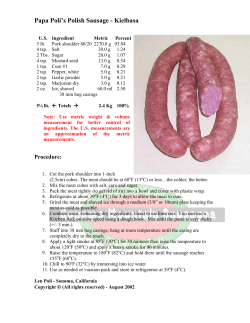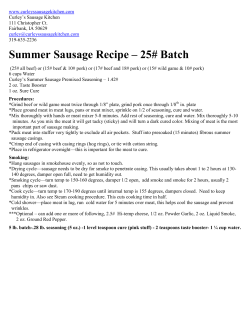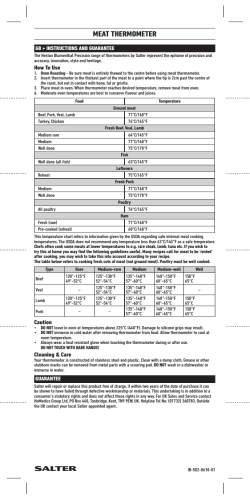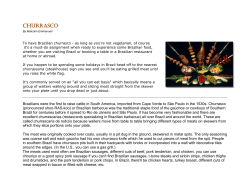
The Who, What & Why of Poaching &
1 Anti-Poaching Course Module # 1 – Component # 1 & The Who, What & Why of Poaching Introduction This course provides a theoretical background in the prevention of poaching, theft and mutilation of game animals from a game reserve environment. If you are a reserve, conservancy, wildlife or game farm manager; game ranger, game guide, game guard, trails guide or field guide this course is for you. Disclaimer This Course is written as a general Guide to Anti-Poaching activities on game reserves. The advice, recommendation, protocols, suggestions and instructions provided should be treated as guidance only. While this course is based upon direct counter-poaching experience, this activity is potentially dangerous and lifethreatening and those involved must be practically trained by experienced personnel before taking any action regarding the subject matter. Therefore, WildlifeCampus takes no responsibility for how you may utilise the information contained within this course and any consequences thereof. The Who, What & Why of Poaching © 2 Anti-Poaching Course What is Poaching? Poaching is the illegal taking of wild plants or animals contrary to local and international conservation and wildlife management laws. Violations of hunting laws and regulations are normally punishable by law and, collectively, such violations are known as poaching. Poaching is in effect the illegal “hunting” of fauna and flora. In this course we will concentrate on poaching, which can be described as killing, trapping, capture, removal or possession of any product of fauna or flora without a permit or permission. The Who, What & Why of Poaching © 3 Anti-Poaching Course What is Anti-Poaching? Anti poaching is the approach, implementation and execution of controlling and elimination of poaching activities. What is an Anti Poaching Unit (APU): this is a team dedicated to eradication of poaching in any form. While you doing the course visualise the content and think of it in a practical context this will aid you in be more effective at anti poaching. Who makes the best anti poaching team members? People often say the best APU members are former military personal. Some people say the best APU are ex-poachers. Both of the above have both got positive aspects. The best person however is a passionate conservationist as that person is willing to push more and give more effort that any highly trained person who does it as a job. In this course we aim to give as much of the skills to make you and your team effective as possible at anti poaching. One needs to be aware that a large amount of the skills needed to be effective at anti poaching, comes from practical experience and training that a written course cannot provide. However, this course will give you the necessary skills to manage anti poaching in most forms. APU in Angola Aims of the course: To provide you and your team the necessary skills and knowledge to eradicate poaching in your area. The Who, What & Why of Poaching © 4 Anti-Poaching Course Three Levels of Poaching Poaching can generally be divided into three different classes. 1) Subsistence Level 1 2) Commercial Level 2 3) Syndicated Level 3 All poaching levels are as equally critical, as they are often interlinked and intelligence passes through all three levels. Subsistence Level This is a person that usually hunts/traps for himself and his family. He will often live in the surrounding areas of his poaching position and will know the terrain, habitat, infrastructure, routines and resident species remarkably well having most often grown up in and around the immediate wilderness area. Characteristics of a Subsistence Poacher This individual is often driven by poverty at first but can quickly cross over to becoming a commercial poacher. He will use whatever he has available to achieve his goal “food”. In a large reserve this person can and often lives on the reserve without anyone being aware of his presence. He generally will have the ability to live off the land. He will often know the reserve equally or better than the reserve management team and will certainly know you there before you know he is there. He is usually armed with his poaching weapons, as well as a knife or machete/ panga as well as an axe. He may also pose threat to any lodges, homesteads or labourer compounds in the form of petty theft. He will almost always avoid any form of confrontation and will attempt to hide from or flee from anti poaching units. He most often operates alone or as a pair. He will generally give up once when caught. He may hunt indiscriminately and will eat whatever caught. Threat level to the anti poaching units is low: 1 -2/5 Methods: this person’s methods include snares and traps, spears and bow & arrows, hunting with dogs and poison baits. In the event that he is able to obtain a firearm, he will frequently progress to a level of commercial poaching. The Who, What & Why of Poaching © 5 Anti-Poaching Course Commercial Poaching Poaching for bush meat, traditional medicine & narcotic sales This person can’t be easily profiled. He may be the farm manager next door or the subsistence level poacher that has “upped his need” or has been requested to obtain certain products. Traditional healers and those who supply them also fall into this category. There are also those who are simply opportunists who move along fence lines looking for vulnerable. Lastly included in this category are plant (cycads and others) collectors. Characteristics of a Commercial Poacher: They generally operate as a group, and are frequently armed with firearms. They are driven by money or even “sport”. They will often sell the meat to butchers or back door street vendors. They may use poison to target certain species for traditional medicine trade. When poaching for meat, they will hunt indiscriminately When poaching for the traditional medicine (Muti-trade) they may well target expensive wildlife to fulfil specific requests. They are often opportunistic with poaching. Their meat sales generally look legitimate, and will often come with proof of purchase. They can be well equipped with firearms, telescopic sights, night vision spotlights, radio communications and vehicles. They will try to avoid confrontation and work on a “kill and get out” principal before anyone comes. They may consider fighting back if their numbers allow but will generally prefer to flee when confronted. They usually target various locations in and around their living environment. They may also work seasonally or at specific times of the month. They generally operate at night. They may remain in larger reserves, living there for a several days while they obtain their required carcasses; this is particularly prevalent during the winter months. This level of poacher may also kill for fun, and leave the carcass where they shoot it. They generally don’t have significant wildlife knowledge or skill. They certainly pose a significant threat to wildlife. Level of threat to the anti poaching unit is moderate: 3.5/5 Methods: These include snares, trapping, spears, bow and arrow, hunting with dogs and hunting with rifles. The Who, What & Why of Poaching © 6 Anti-Poaching Course Syndicate Poaching This is sophisticated organised crime, well funded, well networked and internationally orchestrated. They recruit large networks of individuals, mostly locals to do the actual poaching. Where syndicate level poachers are encountered it’s the lowest level of the syndicate. Characteristics of Syndicate Poachers They are highly organised, resourced and operate within a sophisticated intelligence network. They always operate in groups, often very large groups of between 5 and 5 members. The upper echelons of the syndicate are driven by a significant monetary motive. The lower levels are also financially motivated, but at a fraction compared with their masters. Ironically the higher the risk of the operation, the lower the operatives are paid. They are exceedingly well equipped with light aircraft, helicopters, assault rifles, explosives, night vision optics, vehicles, (encrypted) radio communication, dart guns and camouflage clothing. They utilise overt or covert surveillance followed by rapid “hit and run” tactics and do not linger after making their kills. Will try to avoid confrontation, but will not hesitate to exercise excessive force when confronted. They operate during the day and at night They are Target Selective, with species including black & white rhino, elephant, lion and leopard. They have the resourced to target large areas. The Syndicates work as businesses They are professionals, frequently with a military or Para-military background and training. Syndicate poachers have extensive skills, knowledge and motivation. Threat to anti poaching unit is extremely high: 5/5 Methods: darting and hunting with firearms on foot, vehicle or helicopter. The Who, What & Why of Poaching © 7 Anti-Poaching Course The Illegal Pet Trade The profile of the illegal pet-trade poacher falls within the subsistence and commercial poacher level. The category is separated out due to the fact that this poacher, unlike the others does not confine his activities to formal reserves. The targeted species of this poacher are mainly reptiles; usually tortoises, chameleons and snakes. While all species certainly occur within formal conservation areas, they are also readily available outside of these areas. This type of poacher is also most difficult to catch red-handed as they do not carry weapons and should they feel they are in an imminent position of being confronted, they simply let their captured animal go. When encountered they are only guilty of trespassing and this type of charge is not frequently pursued unless the individual becomes a repeat offender. However when they are encountered the immediate area should be searched for their targeted species, and these species should be removed elsewhere, as the poachers will often return to an areas where they may have “left” their last captured animal. The animals removed from formal or informal reserves are generally sold on the side of the road. This practice is illegal and the species offered for sale do require permits form Provincial nature Conservation Departments in order to possess them. When the informal traders are encountered, local police should be informed and the animal for sale should never be purchased. People frequently purchase the species, not necessarily to keep them as “pets” but rather with the idea of returning them to the bush. While noble in intention, this practice simply fuels the demand and thus encourages poaching. If nobody bought, the trade would naturally dissolve. The “going rate” for a chameleon in September 2011 was R 450.00 for a juvenile. The Who, What & Why of Poaching © 8 Anti-Poaching Course Species Targeted Subsistence Level 1 Commercial Level 2 Syndicated Level 3 Species Baboons Savanna Birds of prey Blesbok Bontebok Buffalo Burchell’s zebra Bushbuck Bushpig Crocodile Damara Dik-dik Duiker blue Duiker grey Duiker red Eland Elephant Gemsbok General birds Giraffe Grey Rhebok Grysbok Cape Grysbok Sharpe’s Hartebeest Lichtenstein’s Hartebeest red Hippo Hyaena spotted Impala black faced Impala common Jackal Klipspringer Kudu Leopard Lion Monkeys vervet Mountain reedbuck Mountain zebra cape Mountain zebra Hartmann’s zebra Nyala Oribi Ostrich Poaching Level Product 2 2 1&2 1&2 1&2 1&2 1&2 1&2 1,2 & 3 1&2 1&2 1&2 1&2 1&2 2&3 1&2 2 1&2 1&2 1&2 1&2 1&2 1&2 1,2 & 3 2 1&2 1&2 2 1&2 1&2 2&3 2&3 2 1&2 1&2 1&2 1&2 1&2 1&2 1&2 The Who, What & Why of Poaching Muti trade Muti trade and live sale Meat Meat Meat and live sale Meat and skin Meat Meat Meat, Skin, Eggs and live sales Meat Meat Meat Meat Meat Ivory Meat Muti trade and live sale Meat Meat Meat Meat and retail live Meat Meat Meat skin and ivory Muti trade Meat Meat Muti trade Meat Meat Skin and Muti trade Skin, live sale and Muti trade Muti trade Meat Meat and skin Meat and skin Meat and skin Meat Meat Meat © 9 Anti-Poaching Course Plants Reedbuck common Rhinoceros black Rhinoceros white Roan antelope Sable antelope Small cats Springbuck Steenbok Suni Tsessebe Warthog Waterbuck Wildebeest black Wildebeest blue 2 &2 &3 &3 &2 &2 2 1&2 1&2 1&2 1&2 1& 2 1& 2 1&2 1&2 1 2 2 1 1 The Who, What & Why of Poaching Muti trade and live sale Meat Horn Horn Meat and live sale Meat and live sale Muti trade and live sale Meat Meat Meat Meat Meat Meat Meat Meat ©
© Copyright 2025









